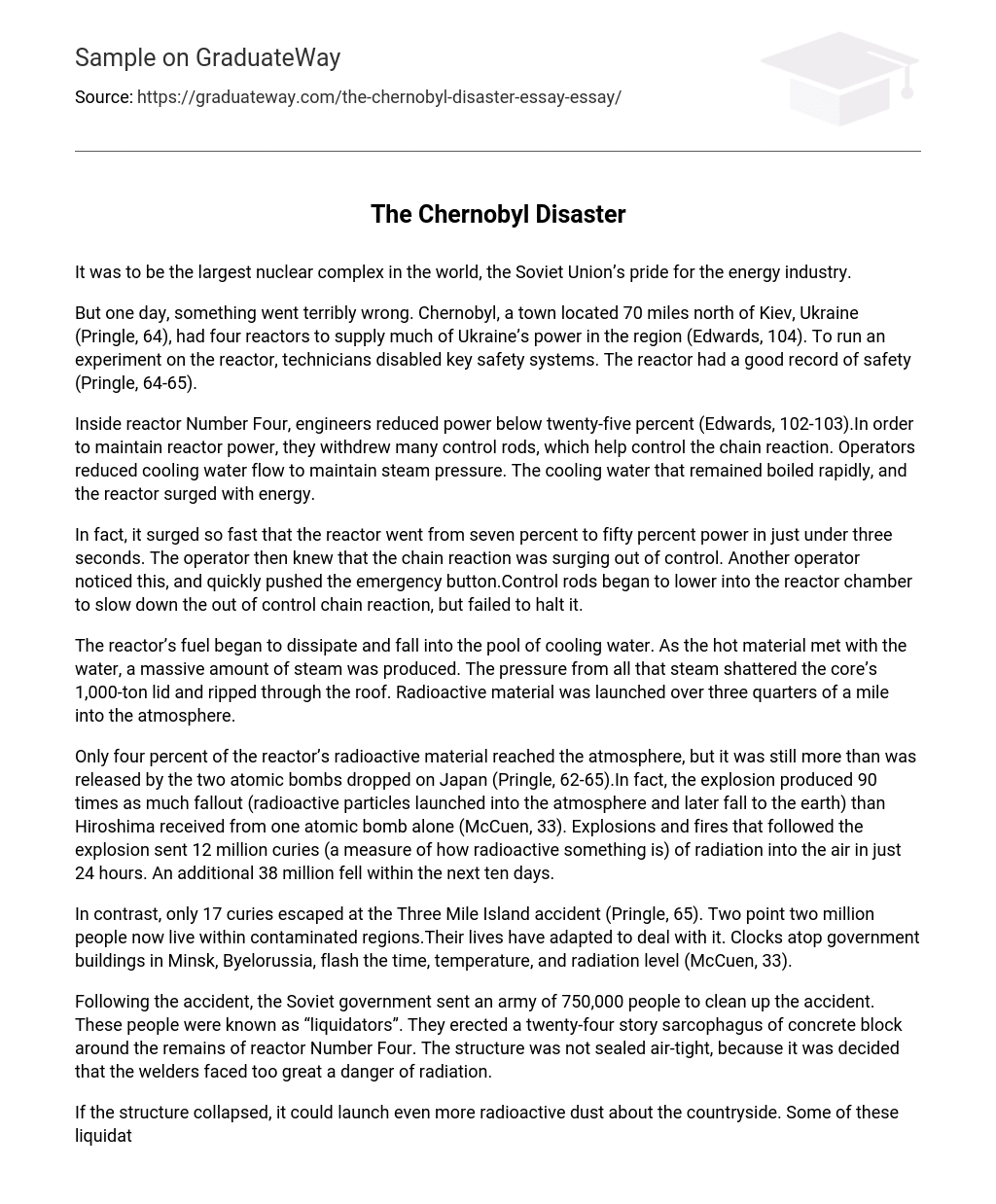It was to be the largest nuclear complex in the world, the Soviet Union’s pride for the energy industry.
But one day, something went terribly wrong. Chernobyl, a town located 70 miles north of Kiev, Ukraine (Pringle, 64), had four reactors to supply much of Ukraine’s power in the region (Edwards, 104). To run an experiment on the reactor, technicians disabled key safety systems. The reactor had a good record of safety (Pringle, 64-65).
Inside reactor Number Four, engineers reduced power below twenty-five percent (Edwards, 102-103).In order to maintain reactor power, they withdrew many control rods, which help control the chain reaction. Operators reduced cooling water flow to maintain steam pressure. The cooling water that remained boiled rapidly, and the reactor surged with energy.
In fact, it surged so fast that the reactor went from seven percent to fifty percent power in just under three seconds. The operator then knew that the chain reaction was surging out of control. Another operator noticed this, and quickly pushed the emergency button.Control rods began to lower into the reactor chamber to slow down the out of control chain reaction, but failed to halt it.
The reactor’s fuel began to dissipate and fall into the pool of cooling water. As the hot material met with the water, a massive amount of steam was produced. The pressure from all that steam shattered the core’s 1,000-ton lid and ripped through the roof. Radioactive material was launched over three quarters of a mile into the atmosphere.
Only four percent of the reactor’s radioactive material reached the atmosphere, but it was still more than was released by the two atomic bombs dropped on Japan (Pringle, 62-65).In fact, the explosion produced 90 times as much fallout (radioactive particles launched into the atmosphere and later fall to the earth) than Hiroshima received from one atomic bomb alone (McCuen, 33). Explosions and fires that followed the explosion sent 12 million curies (a measure of how radioactive something is) of radiation into the air in just 24 hours. An additional 38 million fell within the next ten days.
In contrast, only 17 curies escaped at the Three Mile Island accident (Pringle, 65). Two point two million people now live within contaminated regions.Their lives have adapted to deal with it. Clocks atop government buildings in Minsk, Byelorussia, flash the time, temperature, and radiation level (McCuen, 33).
Following the accident, the Soviet government sent an army of 750,000 people to clean up the accident. These people were known as “liquidators”. They erected a twenty-four story sarcophagus of concrete block around the remains of reactor Number Four. The structure was not sealed air-tight, because it was decided that the welders faced too great a danger of radiation.
If the structure collapsed, it could launch even more radioactive dust about the countryside. Some of these liquidators received over 200 REMs of radiation (Edwards, 115) (a measurement of biological tissue damage caused by radiation (Pringle, 116)). This is enough to cause acute radiation sickness, a breakdown of the body’s systems characterized by diarrhea, vomiting, and nausea. 5 REMs are the maximum dosage of radiation permitted yearly for any U.
S. worker. An estimated 180 tons of uranium fuel remain in the rubble, scattered or even fused with melted concrete or steel.Chernobyl had four reactors.
Numbers One and Three are still functioning, but they are unsafe. Number Two was shut down after a fire in 1991. Two operators were fired due to this incident. Five survivors were jailed, but they were later released because they had not been informed that graphite-core reactors will become dangerously unstable at low power.
Operating manuals, also, made no mention of this shortcoming. Now the rules prohibit operating below one quarter power. Ukraine is concerned about their future. Chernobyl-related matters consume fifteen percent of their budget.
Fifteen of these reactors still operate in Ukraine, Russia, and Lithuania. With their economies in chaos, they all exploit them for electricity (Edwards, 101-104). Today, Chernobyl just seems to be a sore thumb for the Ukraine. The government knows how dangerous it is to keep these reactors running but continues to run them to avoid energy shortages.
One thing is for sure, however; the environmental impact of this incident is undeniable. Chernobyl has affected almost 5 million people, and if nuclear power is to have a future, we must learn from our mistakes.





